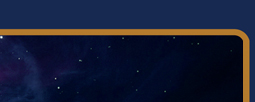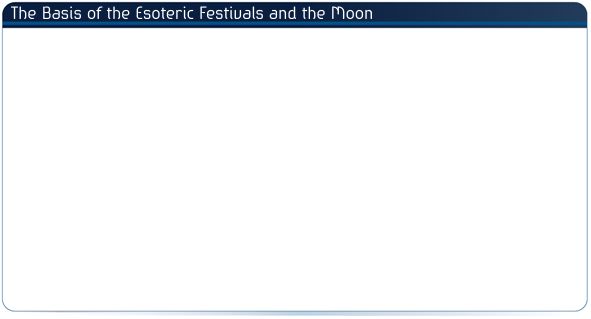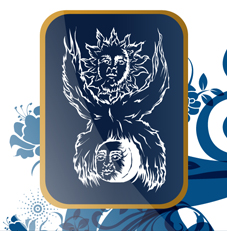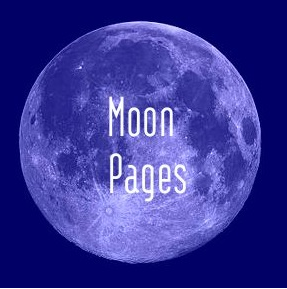







THE BASIS OF THE SOLAR ESOTERIC FESTIVALS[1]“Three things cannot be hidden: the moon, the sun and the truth…” The cycles of the moon and the sun have been central to the development of human life, society and consciousness throughout the ages. Since before recorded history we planted according to the moon, structured our activities around the seasons, conceived and gave birth to our babies in tune with the lunar phases. Our cultures evolved celebrations, festivals and commemorations of important events by marking the interrelationship of the sun and moon, and we learned to anticipate impending major events in our societies by the passage of eclipses. The sun and the moon were the first ‘planets’ we observed as we evolved the numerous astrological systems in our various world cultures. Up until very recently in human history, when the electric light bulb replaced our reliance on fire and the sun, we based the very rhythm of life itself on the rising and setting of the sun. When the sun gave light to the day, we were conscious in our phenomenal world. At night, when the only light available was from the moon or from fires, we entered the realm of dreams and subjective realities. Modern societies have lost touch with these cycles, yet the cycles still function, though more subconsciously these days. In the books of Alice A. Bailey great importance is placed upon the necessity for meditation at the period of the full moon. It is the same in Eastern religions. At the full moon the sun and moon are in exact opposition and so the moon is fully illuminated by the light of the sun. In esoteric astrology the sun represents the higher aspects of every person—the solar angel[2]—whereas the moon represents the past and the lower nature, the lunar lords, or the persona. Therefore the full moon periods have been referred to as the “solar festivals”[3] or the ‘solar fire festivals.’ The solar festivals span five days[4] for the average full moon—two days preceding, the day of the lunation itself, and the two days following. At the full moon the greatest light shines upon the earth, and the solar angel and the great meditators of the world are more easily accessed. At this time there is greater potential for alignment between the higher and lower aspects of human nature and thus an opportunity for the greatest amount of subjective influence to be manifested in the world.[5] There is much to support this view in the world religions as well[6] and especially in the Mahayana and Vajrayana Buddhist traditions which are based in the lunar month, with the solar month as a modern overlay. It is the relationship between the sun and the moon which is of importance in determining and celebrating the solar festivals in those traditions, along with the Sun signs, and it is in that word relationship that the whole idea of the solar festivals begins to take on its true meaning. Each full moon has its own unique character, according to the astrological signs involved. There are also solar festivals at times other than the full moon, all taking their timing from the relationship between the sun and moon. In the context of the solar festival then, the full moons are denoted according to the sign in which the Sun is posited at the time of the full moon, and not that of the Moon. For example, the Festival of Aries denotes the full moon period when the Sun is in Aries and the Moon is in Libra. The Sun is the factor of major importance, with the Moon as a reflective influence. However, it is actually neither the Sun nor the Moon which are of importance when considering the full moons with respect to their spiritual festivals. Rather, both Sun and Moon veil other influences in esoteric astrology.[7] If we only stop and investigate a little, these cycles of relation between the sun and the moon still remain valid in our lives. Many emergency medical specialists may be able to tell you, for instance, when the moon is full, because the emergency wards of hospitals often do a booming business at those times. There is currently little scientific evidence from studies to support this, but I have heard directly from emergency workers who swear by the fact. The same is said to be true of psychiatric wards. Experienced hairdressers can tell you that getting one’s hair cut on the waxing moon gives a fuller and more rapid growth of hair. Biodynamic and organic farmers plan by the moon for planting and animal husbandry. The tides rise and fall according to the moon. Animals spawn and mate according to the moon and only in certain seasons, as proscribed by the sun. Yes, the physical cycles of the sun and moon are still very much in evidence if we care to look, yet in our modern age we seem to want to deny them, to think the wisdom and lore about them to be ancient mythology, or that they do not apply in our enlightened times. Such is the arrogance of our materialistic world: to think that nature and extra-planetary bodies have no effect on human life, that we are somehow above such influences. Yet, such is not the case. Aside from physical effects, the sun, moon and planets have a profound effect upon our subjective states of being, as any astrologer can tell you. Our languages and thus our systems of learning have evolved around these very solar/lunar cycles. The sun has always been associated with life, vigor, objectivity and the ability to rule over the environment and people. It is equated with the masculine—yang—with luminescence and the furtherance of culture. Light has a connection with enlightenment and revelation, thus the sun’s association with learning and spirituality. The moon, as the complementary polarity, has always been associated with the processes of conception, gestation and birth, women’s cycles, tradition, generation. Thus it is equated with the feminine, the subjective side of life—yin—and with the less understood manifestations of the human psyche, hence our references in language to lunatics and the like. Though in some ancient cultures the moon was seen as a masculine deity and the sun as feminine.[8] Religious and moral disciplines frequently use the sun and moon in their symbolism. In Tibetan Buddhist tantra, for instance, the sun is seen as the symbol of the method aspect, whereas the moon is equated with wisdom. When method and wisdom are united, then full enlightenment is said to be possible. Method is equated with the male, or father, whereas wisdom is equated with the feminine, or mother. The sun and the moon in the Buddhist system signify the two halves of the very essence of the path to enlightenment—the yang and yin—of the Great Enlightenment. The quote at the opening of this article is a simplification of a longer quote from “The Book of Threes” of the Pali Canon,[9] but has been variously attributed to either the Buddha or to Confucius.[10] The fact that it is in our consciousness is enough, and it goes straight to the heart of the purpose of this little work. It is not my intent here to enter into a discussion about the lunar phases and their significance, or the mechanics of the soli-lunar cycles. That has been more than adequately covered in other works.[11] Rather it is the moon, the sun and the truth—and their interaction, primarily with respect to astrology, which are at the basis of the esoteric side of the lunar festivals. Through the long ages and the processes of evolution that interaction gave rise first to biological imperatives, then to intelligent living within the natural cycles and eventually to the wisdom borne of experience—the blending of method and wisdom, which is equated with truth. Since I started writing full moon letters in earnest in 2003 we have seen the ongoing “war on terror,” some rather major disasters such as the Sumatra Tsunami, Hurricane Katrina, the financial collapse of 2008–2009. There has been no want of things for the mundane astrologer to investigate. Yet, the question that kept coming to my mind is what all these events were actually impressing upon the collective human psyche. What did the events mean to us as humanity? Was there some sort of evolutionary impulse behind everything? Were we in fact evolving as a result of the stresses in the world? What is the interaction between human thought, world events, extra-planetary activity such as sunspot activity, and factors of which we have no real cognizance whatsoever, such as the meditative power of the great beings who collectively look after the welfare of our little world, or even this world itself as an living being? There is no denying the effects of the phenomenal events that have taken place in the last decade on our collective human thought and well-being. These pages are meant for those who seek a deeper understanding of the dance of cycles that has been ongoing throughout the history of our world—the sun and the moon and their interrelation with our globe. Here we seek to see how factors as fundamental as the Sun and the Moon in astrology can have such an overarching emphasis on human and planetary affairs and how the other planets in astrology blend with them and add their own influences. Most of all, we seek to gain meaning from the cycles of the Sun, referring to the astrological signs and the seasons, and the full moons as a reflective, subjective overlay. And hopefully, we can begin to reinstitute interest in the cycles that have gradually slipped below our threshold of consciousness, yet beckon us to reach beyond the usual levels of our mind into realms more sublime, ideas more potent, life more profound, and interaction with the divine in each of us more meaningful, more urgent and more real. In a world that lives increasingly in the clamor of technology and society and from one sound bite or video clip to the next and where people want answers in an instant, we need more than ever to reconnect with the basic rhythms of our lives, but especially with the inner voice within each of us that we can hear and answer only in the stillness of our meditative focus or reflective thought. In these pages may you, too, find a renewed inspiration and interest similar to that which the study of the full moons has brought to me over the years. Malvin Artley March 2012 [1] Extracted and adapted from the introductory chapter of my book, The Full Moons: Topical Letters in Esoteric Astrology. You can find more information about that at www.malvinartley.com/news_west.htm [2] From the Sanskrit, atma/buddhi/manas. The aggregates of consciousness, karmic volition and the more rarified aspects of conceptual thought, respectively, from Buddhist teaching. [3] “Solar festival” and “solar fire festival” are terms that have been coined to describe the festivals of the full moon as they are related in the works of Alice Bailey, most notably among people who are or who have been associated with The University of the Seven Rays and The Seven Ray Institute, either directly or through outreach. See: www.sevenray.net. [4] Esoteric Healing, p. 341. [5] Ibid. [6] This is particularly true of Christianity and Buddhism, although Taoist, Jewish and many pagan religious rituals are reckoned around the full moon. There is not the space to go into the various religions and their connections with the full moons here. The most notable example from Christianity is the determination of the date of Easter, and readers familiar with esoteric astrology know that the Easter full moon is one of the main spiritual festivals of the year, connected with the resurrected Christ. [7] From the section “Three Basic Statements,” and from the comments on Tabulation III at the start of Esoteric Astrology. [8] Male moon gods, such as Sin, of Mesopotamia; Mani, of the Germanic tribes; Tsukuyomi, of ancient Japan. Female sun goddesses were featured in those cultures. [9] The Pāli Canon is also known as the Tripitaka (the “Three Baskets”), and is the standard collection of scriptures of Theravadan Buddhism; the sutra path. It was committed to writing during the Fourth Buddhist Council in Sri Lanka in 29 BCE. It is composed of three volumes: Vinaya Pitaka (the rules for monks and nuns), Sutra Pitaka (discourses, mostly by the Buddha but also by some of his disciples), and Abhidharma Pitaka (philosophy, psychology and metaphysics). [10]The original quote runs: “Monks, there are three things which shine forth for all to see, which are not hidden. Which three? The disc of the moon shines for all to see: it is not hidden. The disc of the sun does likewise. The dharma discipline of a Tathagata shines for all to see: it is not hidden. These are the three things.” From The Book of Gradual Sayings, Vol I, “The Book of Threes,” Pali Text Society pubs., Melksham, Wilts, UK. The most common form of the quote in the vernacular is: “Three things shall not long remain hidden: the sun, the moon and the truth.” The usage of “long” is a corruption of the original quote. Even though the Sun and Moon go through their cycles and are periodically hidden from view, we know they are always there. [11] Most notably, Dane Rudhyar, The Lunation Cycle: A Key to the Understanding of Personality, Aurora Press, Santa Fe, NM, US; Thomas Poppe, Moon Time: The Art of Harmony With Nature and the Lunar Cycles, Random House, UK; Johanna Paungger, Guided by the Moon: Living in Harmony with the Lunar Cycles, De Capo Press, Germany. |
